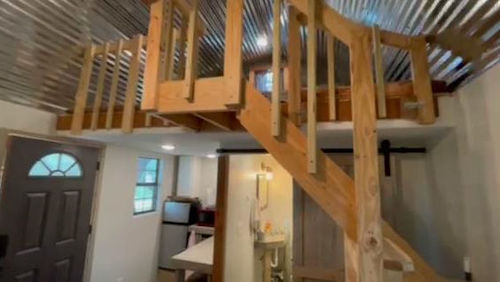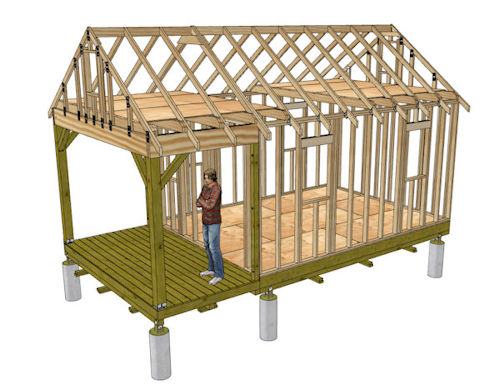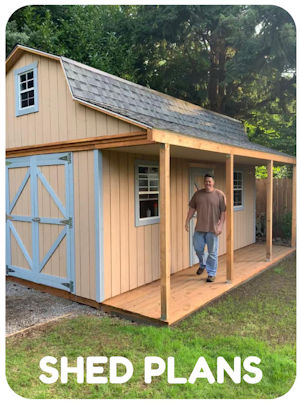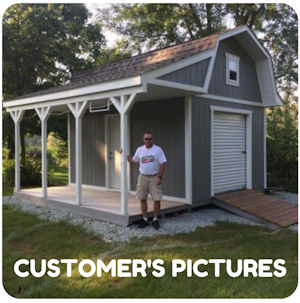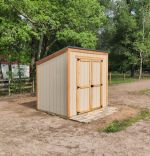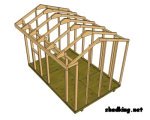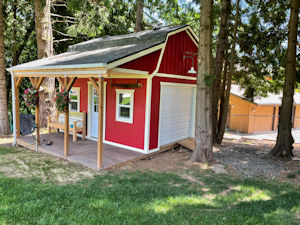Want to Save 20% off Any Shed Plan Purchase!
Signup For My 'Shed n Sight' Newsletter
and Get Your 20% off Promo Code To Use At Checkout.
- Home
- All About Shed Houses
- Turning your shed into a house
How To Turn a Shed Into a House
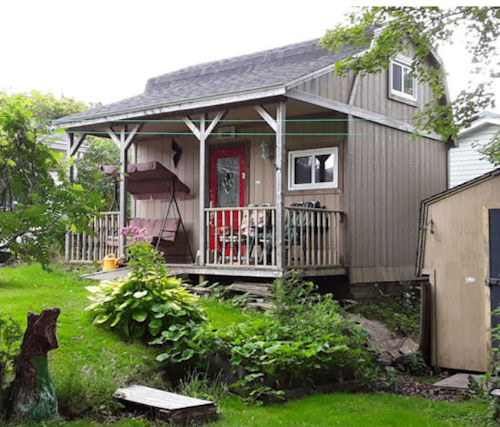 How To Turn a Shed Into a House
How To Turn a Shed Into a HouseAre you one of the many homeowners wanting to know how to turn a shed into a house? Are you wondering if it's a good idea?
Have you seen the housing market lately? The possibility of converting a backyard shed into a house might be the best option and a popular option for you to get that extra space you need to build a:
- Shed house
- Air BnB
- Full Guest House
- Granny flat
- Home office
- Music studio
- She shed
- Art studio
One of the best ways to achieve any of the above is by converting a backyard storage shed into a livable house. Not only is this an affordable and environmentally friendly option, but it also allows homeowners to maximize the use of their outdoor space. In this ultimate guide, I will take you through the process of converting your backyard shed into a livable space.
Hey, it's a great idea you've got here! Livable sheds are a good option for personal dwellings!
Shed Houses are Affordable and Environmentally Friendly
One of the best ways to achieve any of the above is by converting a backyard storage shed into a livable house. Not only is this an affordable and environmentally friendly option, but it also allows homeowners to maximize the use of their outdoor space. In this ultimate guide, I will take you through the process of converting your backyard shed into a livable space.
Hey, it's a great idea you've got here! Livable sheds are a good option for personal dwellings!
Benefits of a Shed Conversion
Converting a storage shed into a tiny house has numerous benefits that make it an attractive option for homeowners.
- Firstly, it is a cost-effective way to increase living space. It is much cheaper than building a traditional house or adding an extension to your existing house.
- Additionally, it is an environmentally friendly option that reduces the carbon footprint of homeowners.
- Another benefit of shed conversion is that it allows homeowners to maximize the use of their outdoor space. Many homeowners have unused storage sheds in their backyard that can be converted into living spaces. This way, the unused space can be transformed into a functional and livable space.
How to turn a shed into a house: Is It Really Possible?
Before embarking on a shed conversion project, it is important to assess the feasibility of the project. You will need to determine if your shed is suitable to be converted.
The first thing to check is to determine if a shed conversion is allowed in your area. It is important to check with your local building department to determine if there are any zoning restrictions or building codes that need to be adhered to. It is also important to obtain any necessary building permits before starting the conversion process.
If you are allowed by your county to convert your shed or build a new one for a livable shed, then here are some questions you need to ask yourself:
- Will the framing of your existing shed accommodate putting in insulation, plumbing, and electricity?
- Will you be able to have running water in your shed? How will you heat your water?
- How about your bathroom? Where will all the waste go?
- Kitchen in your shed house? This is a must have!
- Where will you get your electricity from? Solar powered or running it from your house?
- Will you be able to heat and cool your shed?
- Will you have room for a bedroom?
- Will you have room for an eating area or living room?
- Will you have room for a washer and dryer?
- Will you have room for storing clothes and other personal objects?
- Will you be able to afford to do all of the above? Are you on a tight budget? Will you need to check into financing options if all of the above runs into a heaping sum of money you don't have?
Building Codes and Permits for A Shed Conversion to a Tiny House Shed
Building codes and permits vary depending on the location and the intended use of the converted shed. In general, a shed that is used as a living space requires a building permit. Additionally, the shed must meet certain building codes and safety standards. These standards include proper electrical wiring, plumbing, ventilation, and insulation. It is important to work with a licensed contractor or get professional help who is familiar with the local building codes and permit requirements. They will be able to ensure that your converted shed meets all the necessary safety and building standards.
Setback requirements determined by the county you live in may be a limiting factor when deciding on whether or not you can have a tiny shed home.
How to turn a shed into a house: What Is The Existing Framing of Your Shed?
Typical walls in a home are framed with wooden 2x4's or sometimes 2x6's and they are spaced 16" on center, 19.2" on center, or 24" on center. Your home might even have metal studs. But this is uncommon with shed construction unless you have metal garden shed of some sort. Roofs are typically built with rafters coming off a ridge board going down to the walls top plates, or they are built with trusses. If your shed is built with walls and roofs that do not have this standard framing you will not be able to run electrical wiring, plumbing, or do insulation effectively. And, your local building department probably won't approve a permit for you to convert your shed.
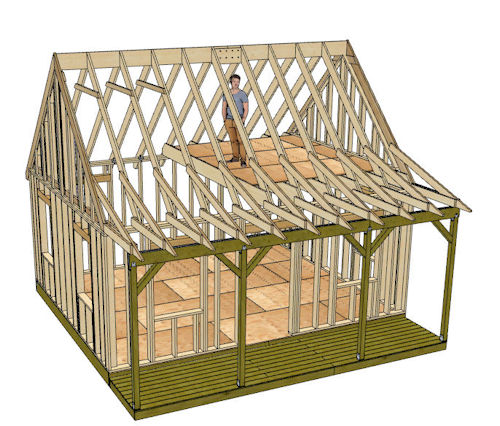 Steep Pitch Gable Roof Has A Loft For a Nice Bedroom
Steep Pitch Gable Roof Has A Loft For a Nice BedroomDoes your shed have a barn or gambrel style roof? Or is it a gable style roof? Maybe you've got a simple shed with a shed roof, or lean to style shed.
If your shed has the barn style roof, this is a great option to have. Why is this? Barn style roofs have lofts that have more room and are great useable spaces for bedrooms! One drawback however with
a barn roof is that when it comes to insulating it is almost impossible to get it insulated properly since your roof cavities will be full of insulation. Typically with a home, which most have a gable style roof, the attic is insulated and you have flow
through ventilation through the eaves and out the roofs ridge vent or other venting systems such as roof vents.
With the lean to style roof, you could possible add ceiling joists and insulate those. Otherwise you would want to insulate the cavities of the roof trusses or rafters.
Insulating and Ventilating Your Shed House
Proper insulation and ventilation are important for the comfort and safety of the occupants of the shed house. Insulation helps regulate the temperature inside the shed house and makes it more comfortable to live in. Additionally, proper ventilation helps improve indoor air quality and prevents the buildup of harmful gases. When it comes to insulation, it is important to use high-quality insulation materials that are appropriate for the climate in your area. Additionally, it is important to ensure that the insulation is installed correctly to avoid any air leaks. Ventilation can be achieved by installing windows, skylights, or a ventilation system. It is important to ensure that the ventilation system is properly sized and installed to ensure proper airflow.
Fiberglass insulation: Pros and cons
Fiberglass insulation is one of the most commonly used insulation materials. It is made from glass fibers that are spun into thin strands and then woven together. The main advantage of fiberglass insulation is its affordability. It is relatively inexpensive compared to other types of insulation. Additionally, fiberglass is non-combustible, which makes it a safe option for homes. However, it is important to note that fiberglass insulation can cause skin irritation and respiratory issues if not installed properly. It also tends to lose its effectiveness over time, as the fibers settle and compact.
Cellulose insulation: Pros and cons
Cellulose insulation is an environmentally friendly option, as it is made from recycled paper products, such as newspapers and cardboard. It is treated with fire retardants to enhance its safety. One of the key advantages of cellulose insulation is its ability to fill small gaps and voids, providing excellent coverage. It is also resistant to pests and mold. However, cellulose insulation can be more expensive than other types, and it requires professional installation to ensure proper density and coverage. Additionally, it may settle over time, leading to a decrease in its insulating properties.
Spray foam insulation: Pros and cons
Spray foam insulation is a versatile option that expands upon application, filling gaps and creating an airtight seal. It can be either open-cell or closed-cell foam, with closed-cell foam providing a higher R-value (thermal resistance). Spray foam insulation offers excellent thermal performance and soundproofing capabilities. It also acts as a barrier against moisture and helps prevent the growth of mold. However, spray foam insulation is one of the more expensive options and requires professional installation. It can also release harmful chemicals during installation, so proper ventilation is crucial.
Reflective insulation: Pros and cons
Reflective insulation, also known as radiant barrier insulation, works by reflecting radiant heat away from the home. It consists of a highly reflective material, such as aluminum foil, installed in the attic or on the roof. Reflective insulation is most effective in hot climates, as it helps keep the home cooler. It is relatively easy to install and does not require professional assistance. However, it is less effective in colder climates, where it may contribute to heat loss. It is also important to ensure proper installation without any gaps or tears to maximize its effectiveness.
Natural insulation options: Pros and cons
For those looking for eco-friendly and sustainable insulation options, natural materials provide an excellent choice. Materials such as wool, cotton, and hemp can be used as insulation, offering good thermal performance and moisture control. Natural insulation is also non-toxic and does not release harmful chemicals into the air. However, it can be more expensive than traditional insulation materials, and it may require professional installation. Additionally, some natural insulation materials may attract pests if not properly treated.
Common insulation mistakes to avoid
When installing insulation, it is essential to avoid common mistakes that can undermine its effectiveness. One common mistake is leaving gaps or voids in the insulation, which can allow heat transfer and compromise energy efficiency. Another mistake is compressing the insulation, as this reduces its thickness and thermal performance. It is also important to ensure proper air sealing, as air leaks can significantly reduce the effectiveness of insulation. Lastly, using the wrong type of insulation for the specific application can lead to subpar results.
How Will You Get Running Water To Your Shed House?
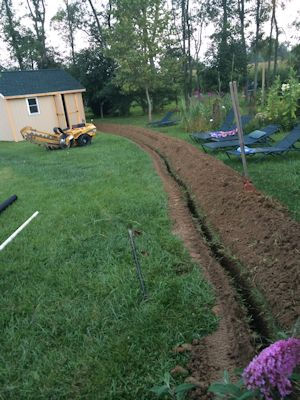 Running a Water Line to Your Shed House
Running a Water Line to Your Shed HouseOne aspect that is often overlooked when it comes to shed houses is the importance of proper plumbing. In order to fully maximize the convenience and functionality of these small dwellings, it is crucial to have a steady water supply. In the information below, I will explore the various aspects of shed house plumbing and provide you with valuable insights on how to ensure a reliable water system for your shed house.
Understanding shed house plumbing
Before diving into the details of planning and installing a water supply system for your shed house, it is essential to have a basic understanding of shed house plumbing. Unlike traditional houses, shed houses typically have limited space and are not connected to the main water supply of a property. As a result, setting up an efficient plumbing system requires careful consideration and strategic planning. Additionally, shed houses often lack the insulation and protection that traditional houses provide, making it crucial to take extra precautions to prevent freezing and other potential issues. By familiarizing yourself with the unique challenges and requirements of shed house plumbing, you can ensure a smooth and hassle-free water supply for your shed house.
Planning your water supply system for a shed house
lanning your water supply system for a shed house Options for getting water to your shed house Installing a water heater in your shed house Heating water in a shed house: Tips and tricks Choosing the right hot water heater for your shed house
When it comes to planning the water supply system for your shed house, there are several important factors to consider. First and foremost, you need to determine your water source. Depending on your location and accessibility, you may have various options available, such as connecting to the main water line, utilizing rainwater collection systems, or drilling a well. Each option has its own advantages and considerations, so it is crucial to evaluate them thoroughly before making a decision. Additionally, you need to consider the water pressure and flow rate required for your shed house. This will depend on your specific needs and the appliances you plan to install. By carefully planning and considering these factors, you can design a water supply system that meets your requirements and ensures a steady flow of water in your shed house.
Options for getting water to your shed house
Once you have determined your water source, the next step is to explore the various options for getting water to your shed house. If you choose to connect to the main water line, you will need to consult with a professional plumber to ensure proper installation and compliance with local regulations. This option provides a reliable and continuous supply of water but may require additional expenses and permits. Alternatively, if you opt for rainwater collection, you can install a system that captures rainwater from the roof of your shed house and stores it in a tank for later use. This environmentally-friendly option can be cost-effective and sustainable, particularly in areas with abundant rainfall. Lastly, drilling a well is another viable option, especially if you have access to groundwater. However, this option may require professional assistance and can be more expensive upfront. By exploring these options and considering their pros and cons, you can choose the most suitable method to get water to your shed house.
Installing a water heater in your shed house
Having a reliable and efficient water heater is essential for a comfortable living experience in your shed house. While traditional water heaters may not be suitable due to their space requirements and energy consumption, there are alternatives specifically designed for small spaces like shed houses. Tankless water heaters, for example, are compact and energy-efficient, providing hot water on demand without the need for a storage tank. These heaters are a popular choice for shed houses due to their space-saving design and cost-effectiveness. Another option is a point-of-use water heater, which is installed directly at the point where hot water is needed, such as the sink or shower. These heaters are compact and can be easily installed, ensuring a steady supply of hot water in your shed house. By selecting the right water heater for your shed house, you can enjoy the convenience of hot water while optimizing space and energy efficiency.
Heating water in a shed house: Tips and tricks
Heating water in a shed house can present unique challenges, especially during colder seasons. To ensure that you have hot water readily available, even in low temperatures, there are several tips and tricks you can follow. First, insulating your plumbing pipes is crucial to prevent freezing and potential damage. By wrapping the pipes with insulation material, you can maintain the temperature and prevent heat loss. Additionally, installing a heat tape or cable along the pipes can provide an extra layer of protection against freezing. Another effective method is to insulate the water heater itself by using an insulation blanket or jacket. This will help retain heat and reduce energy consumption. Finally, consider installing a recirculating pump to minimize water waste and ensure instant hot water at the faucet. By implementing these tips and tricks, you can effectively heat water in your shed house and overcome the challenges associated with colder temperatures.
Choosing the right hot water heater for your shed house
Selecting the right hot water heater for your shed house is essential to ensure optimal performance and energy efficiency. As mentioned earlier, tankless water heaters and point-of-use heaters are popular choices for shed houses due to their compact size and energy-saving features. However, there are other factors to consider when making your decision. The capacity of the water heater, for example, should be determined based on your specific needs and usage. Additionally, consider the energy source of the heater - whether it is electric, gas, or solar-powered. Each option has its own advantages and considerations, so it is important to evaluate them based on your shed house's requirements and available resources. Finally, consider the warranty and lifespan of the water heater, as investing in a durable and reliable product will save you money in the long run. By carefully considering these factors and doing thorough research, you can choose a hot water heater that meets your shed house's needs and provides efficient performance.
Designing Your Shed House
Designing Your Awesome and Efficient Bathroom In Your Shed House
When it comes to designing a shed house, every inch of space matters. This includes the bathroom, which can often be a challenge due to the limited square footage. However, with careful planning and smart design choices, you can create a shed house bathroom that is both functional and stylish.
Benefits of designing a shed house bathroom
Choosing the right toilet for a shed house bathroomDesigning a functional and stylish shower in a shed house bathroomFactors to consider when designing a shed house bathroomMaximizing space in a shed house bathroomCreative storage solutions for a shed house bathroomLighting and ventilation considerations for a shed house bathroomFlooring and wall options for a shed house bathroom
Designing a shed house bathroom has several benefits. One of the main advantages is the ability to customize the space according to your specific needs and preferences. Unlike traditional bathrooms, shed house bathrooms don't have to conform to standard dimensions, allowing for more creative design possibilities.
Choosing the right toilet for your shed house bathroom
Choosing the right toilet for your shed house bathroom is an important decision that can impact both the functionality and style of the space. With limited space, it's important to choose a toilet that is compact and space-saving.
Another option is to choose a compact toilet with a round bowl instead of an elongated one. Round bowl toilets are shorter in length, making them ideal for small bathrooms. Additionally, consider choosing a toilet with a slim tank to further save space.
When it comes to style, there are many options available. Whether you prefer a traditional, classic look or a modern, sleek design, choose a toilet that complements the overall style of your shed house bathroom. Consider the material, color, and shape of the toilet to create a cohesive and stylish look.
Designing a functional and stylish shower in a shed house bathroom
The shower is an essential part of any bathroom, and designing a functional and stylish shower in a shed house bathroom requires careful consideration.
Firstly, think about the size and layout of your shower. In a small shed house bathroom, a walk-in shower or a shower stall with a glass enclosure can help create a more open and spacious feel. Consider using a corner shower to maximize space or a curved shower enclosure to add a touch of elegance.
When it comes to shower fixtures, choose ones that are both functional and aesthetically pleasing. Opt for a showerhead with adjustable settings to suit different preferences. Consider installing a handheld showerhead for added flexibility. Additionally, choose fixtures with a sleek and modern design to enhance the overall style of your bathroom.
To prevent water from splashing outside the shower area, consider incorporating a shower curtain or a glass door. A shower curtain can add a pop of color or pattern to your bathroom, while a glass door can create a more luxurious and spa-like feel.
Lastly, don't forget about the importance of proper ventilation in your shower area. Install a ventilation fan or a window to prevent mold and mildew growth. This will ensure that your shed house bathroom remains fresh and clean.
Factors to consider when designing a shed house bathroom
Before diving into the design process, there are a few factors to consider when designing a shed house bathroom. Firstly, it's important to determine the size and layout of the bathroom. Measure the available space and consider the placement of doors, windows, and plumbing fixtures. This will help you determine how to best utilize the available space and ensure a functional design.
Another factor to consider is the overall style and aesthetic of your shed house. Whether you prefer a modern, minimalist look or a rustic, cozy feel, the design of your bathroom should complement the rest of the house. Take into account the materials, colors, and finishes that will be used in other areas of the shed house to create a cohesive look throughout.
Lastly, think about the specific needs of your household. If you have children or elderly family members, you may want to consider incorporating accessibility features such as grab bars or a walk-in shower. Additionally, if you have a large family, you may need to prioritize storage space in your design.
Maximizing space in a shed house bathroom
One of the biggest challenges when designing a shed house bathroom is maximizing the available space. With limited square footage, every inch counts. There are several strategies you can use to make the most of your space.
Firstly, consider the placement of fixtures. Opt for a wall-mounted toilet and sink to free up floor space. This will create a more open and spacious feel in the bathroom. Additionally, choose compact fixtures that are specifically designed for small spaces. There are many space-saving options available on the market that are both functional and stylish.
Another way to maximize space is through clever storage solutions. Utilize vertical space by installing shelves or cabinets above the toilet or sink. Consider using recessed storage options to save space and create a streamlined look. Additionally, think about using multifunctional furniture, such as a vanity with built-in storage or a mirror cabinet.
Lastly, don't forget about the importance of organization. Keep your shed house bathroom clutter-free by implementing storage systems and regularly decluttering. This will not only make the space feel larger but also improve the overall functionality of the bathroom.
Creative storage solutions for a shed house bathroom
In a shed house bathroom, creative storage solutions are key to keeping the space organized and functional. With limited square footage, it's important to think outside the box when it comes to storage options.
One creative storage solution is utilizing vertical space. Install floating shelves or wall-mounted cabinets above the toilet or sink to take advantage of unused wall space. This will provide additional storage for towels, toiletries, and other bathroom essentials without taking up valuable floor space.
Another option is to incorporate recessed storage. Recessed shelves or cabinets can be installed into the walls, creating a streamlined look while providing hidden storage space. This is especially useful in small bathrooms where every inch counts.
Consider using multifunctional furniture to maximize storage space. For example, choose a vanity with built-in drawers or shelves to store toiletries and towels. Alternatively, opt for a mirror cabinet that combines a mirror with hidden storage behind.
Lastly, don't forget about utilizing the space above the door. Install a shelf or a small cabinet above the door to store items that are not frequently used, such as extra towels or cleaning supplies.
By incorporating these creative storage solutions, you can make the most of your shed house bathroom and keep it organized and clutter-free.
Lighting and ventilation considerations for a shed house bathroom
Proper lighting and ventilation are essential in a shed house bathroom to create a comfortable and functional space. Without adequate lighting, the bathroom can feel dark and unwelcoming. Without proper ventilation, the bathroom can become humid and prone to mold and mildew growth.
When it comes to lighting, consider a combination of natural and artificial light sources. Maximize natural light by installing windows or skylights. This will not only provide a bright and airy atmosphere but also help save on energy costs. Additionally, choose artificial lighting fixtures that provide ample light for tasks such as applying makeup or shaving. Consider installing a combination of overhead lights, vanity lights, and recessed lights to create a well-lit space.
Proper ventilation is crucial in a shed house bathroom to remove excess moisture and prevent mold and mildew growth. Install a ventilation fan that is appropriately sized for the space to ensure proper airflow. Additionally, consider installing a window that can be opened to allow fresh air to circulate. This will help maintain a clean and healthy environment in your shed house bathroom.
Flooring and wall options for a shed house bathroom
The choice of flooring and wall options in a shed house bathroom can greatly impact the overall style and functionality of the space. With limited square footage, it's important to choose materials that are both durable and visually appealing.
For flooring, consider options that are moisture-resistant and easy to clean. Porcelain or ceramic tiles are popular choices for shed house bathrooms due to their durability and low maintenance. Additionally, tiles can add a touch of elegance and sophistication to your bathroom. If you prefer a warmer and cozier feel, consider using vinyl or laminate flooring that mimics the look of wood or stone.
When it comes to walls, there are several options to choose from. Tiles are a popular choice for both the walls and the shower area due to their water resistance and easy maintenance. Opt for larger tiles to create a seamless and spacious look. Alternatively, consider using waterproof paint or wallpaper specifically designed for bathrooms. Choose colors and patterns that complement the overall style of your shed house bathroom.
Incorporating sustainable and eco-friendly features in a shed house bathroom
Incorporating sustainable and eco-friendly features in your shed house bathroom not only benefits the environment but also enhances the overall functionality and style of the space. With a growing focus on sustainability, there are many options available to make your bathroom more eco-friendly.
How to turn a shed into a house: What about the kitchen?
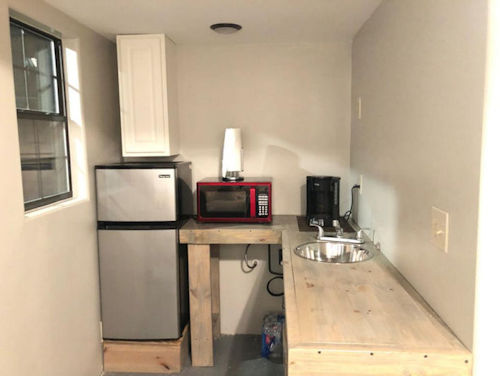 Small Kitchen In This Shed House
Small Kitchen In This Shed HouseMaximizing Space in a Shed Kitchen
One of the biggest challenges of a shed kitchen is limited space. However, with careful planning and organization, you can maximize the available space and create a functional cooking area. One effective strategy is to utilize vertical space by installing shelves or hanging racks for pots, pans, and utensils. This helps to keep your countertops clear and allows for easy access to frequently used items.
Another space-saving tip is to invest in multi-functional furniture. For example, consider a kitchen island with built-in storage or a fold-down table that can be used for food preparation and dining. Additionally, make use of wall-mounted magnetic knife strips or spice racks to keep your kitchen tools within reach without taking up valuable counter space.
How Do You Get Rid of The Sewage and Waste Water?
One of the unique challenges that shed house owners face is the management of sewage and waste water. Unlike traditional houses, shed houses often lack access to municipal sewage systems, requiring homeowners to find alternative solutions. I will explore the importance of maintaining a clean and hygienic shed house, common issues with shed house sewage systems, and effective strategies for dealing with sewage and waste water.
Understanding Sewage and Waste Water in Shed Houses
Sewage and waste water are by-products of our daily activities, and it is crucial to understand their proper management. In shed houses, sewage refers to the wastewater that comes from toilets, showers, and sinks, while waste water encompasses all other types of water waste, such as laundry water or rainwater runoff. Proper disposal and treatment of sewage and waste water are essential to prevent contamination, odors, and health hazards.
The Importance of Maintaining a Clean and Hygienic Shed House
Maintaining a clean and hygienic shed house is not only crucial for the comfort and well-being of its occupants but also for the overall safety of the environment. Improper management of sewage and waste water can lead to the spread of diseases, groundwater contamination, and damage to the ecosystem. By implementing effective strategies for dealing with these waste products, shed house owners can ensure a healthy living environment for themselves and their neighbors.
Common Issues with Shed House Sewage Systems
Shed house sewage systems often face specific challenges due to their unique construction and lack of access to municipal services. Some common issues include inadequate septic tank capacity, improper drainage, and absence of sewage disposal systems. These problems can result in sewage backups, foul odors, and even damage to the shed house structure. It is essential for shed house owners to be aware of these issues and take proactive measures to address them.
Effective Strategies for Dealing with Sewage and Waste Water in Shed Houses
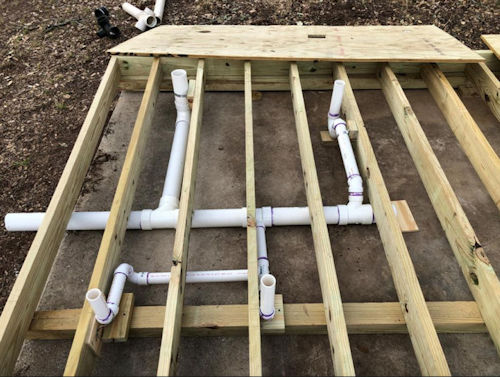 Example ofRough Pvc Plumbing for A Shed House
Example ofRough Pvc Plumbing for A Shed HouseInstalling a Proper Sewage Disposal System in Your Shed House
The first step in managing sewage and waste water in a shed house is to install a proper disposal system. This can involve the installation of a septic system, which collects and treats sewage before it is released into the ground. It is essential to consult with professionals who specialize in shed house sewage systems to ensure the system is designed and installed correctly for optimal functionality.
Regular Maintenance and Inspection of Sewage Systems
Once the sewage disposal system is in place, regular maintenance and inspection are crucial to prevent issues and ensure its proper functioning. Shed house owners should schedule regular inspections to check for signs of damage or blockages. Additionally, septic tanks require periodic pumping to remove accumulated solids. Following a maintenance schedule and keeping records of inspections and maintenance activities will help in identifying and resolving potential problems before they escalate.
Dealing with Sewage Backups and Blockages in Shed Houses
Despite proper maintenance, sewage backups and blockages can still occur in shed houses. When faced with such issues, it is important not to panic. First, turn off the water supply to prevent further damage. Next, attempt to locate the source of the backup or blockage. In some cases, simple solutions like using a plunger or drain snake may be effective in resolving the problem. However, if the issue persists or if there is a risk of contamination, it is advisable to seek professional assistance to address the problem promptly.
Eco-Friendly Options for Waste Water Management in Shed Houses
In addition to proper sewage disposal, shed house owners can explore eco-friendly options for waste water management. Implementing systems such as rainwater harvesting or greywater recycling can help reduce water consumption and minimize the environmental impact of shed house living. Rainwater can be collected and used for irrigation or flushing toilets, while greywater from showers and sinks can be treated and reused for non-potable purposes. These eco-friendly options not only contribute to a cleaner and greener shed house but also promote sustainable living practices.
Powering Up Your Shed House: Traditional Electric or Solar Power?
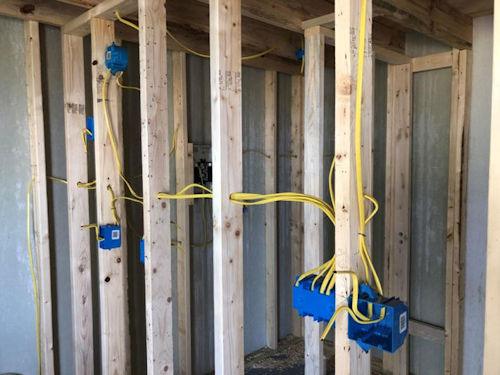 This Shed House Has 12/2 Wiring
This Shed House Has 12/2 WiringWhen it comes to powering your shed house, there are two main options to consider: traditional electric power and solar power. Each has its own set of advantages and disadvantages, and in this article, we will explore both in detail to help you make an informed decision. Whether you are building a shed house from scratch or looking to upgrade your current power source, understanding the pros and cons of each option is crucial. So let's dive in and explore the world of shed house power sources.
Understanding Traditional Electric Power for Shed Houses
Traditional electric power, supplied by the grid, is the most common power source for shed houses. It offers a reliable and consistent supply of electricity, making it convenient for everyday use. With traditional electric power, you can easily connect your shed house to the existing power grid, allowing you to power all your electrical appliances and lighting fixtures without any hassle.
However, there are a few downsides to consider. First and foremost, traditional electric power can be expensive, especially if you are using a large amount of electricity on a regular basis. Additionally, it can be challenging to install the necessary wiring for your shed house, especially if you are not experienced in electrical work. Hiring a professional electrician is often required to ensure the job is done safely and correctly.
Pros and Cons of Traditional Electric Power for Shed Houses
Traditional electric power offers several advantages. It provides a reliable source of electricity, ensuring that your shed house is always powered. This is particularly important if you are using your shed house for work or as a storage space for valuable equipment. With traditional electric power, you can easily connect your shed house to the grid and enjoy the convenience of having electricity readily available.
However, there are also disadvantages to consider. One major drawback is the cost. The electricity bills for a shed house connected to the grid can quickly add up, especially if you are using a significant amount of power. Additionally, the process of wiring a shed house with traditional electric power can be complex and time-consuming. It may require hiring a professional electrician, which can incur additional expenses.
Wiring a Shed House with Traditional Electric Power
Wiring a shed house with traditional electric power requires careful planning and execution. Before starting the wiring process, it is essential to create a detailed electrical plan, outlining the locations of outlets, switches, and lighting fixtures. This plan will serve as a guide during the installation process and ensure that all electrical components are properly connected.
To begin, you will need to install a circuit breaker panel in your shed house. This panel acts as a central hub for all the electrical circuits in your shed house, allowing you to control and distribute power to different areas. Next, you will need to run electrical wires through the walls and ceilings, connecting them to outlets, switches, and light fixtures as per your electrical plan. It is crucial to follow all safety guidelines and local building codes to ensure a safe and compliant installation.
Introduction to Solar Power for Shed Houses
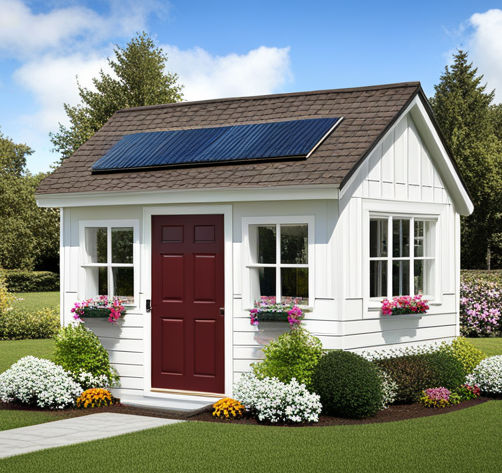 Shed House With Solar Roof Panels
Shed House With Solar Roof PanelsSolar power is an environmentally friendly and sustainable alternative to traditional electric power. It harnesses the energy of the sun and converts it into electricity using solar panels. Solar power offers several benefits, making it an attractive option for shed house owners looking to reduce their carbon footprint and decrease their reliance on the grid.
One of the primary advantages of solar power is its renewable nature. The sun is an abundant source of energy, and harnessing its power can significantly reduce your shed house's environmental impact. Solar power also offers long-term cost savings. While the initial installation cost may be higher than traditional electric power, solar power systems have a longer lifespan and require minimal maintenance. Additionally, solar power can provide energy independence, allowing you to generate your electricity and potentially sell excess power back to the grid.
Pros and Cons of Solar Power for Shed Houses
Solar power has many advantages for shed houses. First and foremost, it is a clean and renewable energy source, reducing your carbon footprint and contributing to a more sustainable future. Solar power systems also require minimal maintenance, making them a hassle-free option for shed house owners. Furthermore, solar power can provide long-term cost savings, as you can potentially reduce or eliminate your reliance on the grid, thereby lowering your electricity bills.
However, there are a few drawbacks to consider. The initial installation cost of solar power systems can be expensive, although there are government incentives and rebates available to help offset the cost. Additionally, solar power is dependent on sunlight, so if you live in an area with limited sun exposure, the efficiency of your solar panels may be affected. It is essential to assess your shed house's location and sun exposure before deciding to go solar.
Installing Solar Panels for Your Shed House
Installing solar panels for your shed house requires careful planning and consideration. First, you will need to assess your shed house's location to determine its sun exposure. Ideally, your shed house should have access to direct sunlight for the majority of the day to maximize the efficiency of your solar panels.
Next, you will need to calculate your power requirements to determine the number of solar panels needed. This calculation will depend on factors such as the size of your shed house, the number of electrical appliances you plan to use, and your daily energy consumption. It is advisable to consult with a solar power professional who can help you assess your needs and design a system that meets your specific requirements.
Once you have determined the number of solar panels needed, the installation process can begin. Solar panels are typically mounted on the roof of your shed house or on a nearby structure, such as a pole or ground-mounted rack. The panels are then connected to an inverter, which converts the DC electricity generated by the panels into AC electricity suitable for use in your shed house. Finally, a battery storage system can be installed to store excess solar energy for later use, ensuring a continuous power supply even during cloudy days or at night.
Comparing the Costs of Traditional Electric Power and Solar Power for Shed Houses
When choosing a power source for your shed house, cost is a significant factor to consider. While traditional electric power offers the convenience of a readily available power supply, it can be expensive in the long run. The cost of electricity from the grid can vary depending on your location and usage, and these costs can quickly add up, especially if you are using a large amount of power.
On the other hand, solar power has a higher upfront cost due to the installation of solar panels and other necessary components. However, solar power offers long-term cost savings. Once the initial investment is recouped, solar power systems can significantly reduce or even eliminate your electricity bills, saving you money in the long term. Additionally, government incentives and rebates are often available to help offset the initial installation cost.
Factors to Consider When Choosing a Power Source for Your Shed House
When deciding on a power source for your shed house, several factors should be considered. First and foremost, evaluate your power requirements. Determine the amount of electricity you need to power your shed house adequately and assess whether traditional electric power or solar power can meet those needs.
Next, consider your budget. Assess the initial installation cost, ongoing maintenance requirements, and potential long-term cost savings for each power source. Additionally, evaluate the environmental impact of each option. Solar power is a clean and renewable energy source, while traditional electric power relies on fossil fuels, contributing to carbon emissions.
Lastly, consider the location of your shed house. Assess the sun exposure for solar power installations and the availability and reliability of the grid for traditional electric power. It is essential to choose a power source that suits your shed house's specific location and requirements.
Understanding the Challenges of Heating and Cooling Your Shed House
One challenge that shed house owners often face is finding efficient heating solutions to keep their space warm and comfortable during the colder months.
Heating a shed house can be particularly challenging due to their small size and limited insulation. Unlike traditional homes, shed houses are not designed with the same level of thermal efficiency in mind. This means that standard heating systems may not be suitable or cost-effective for these types of structures. In this comprehensive guide, we will explore various heating solutions and strategies that can help you effectively heat your shed house while keeping energy costs to a minimum.
Before we delve into the different heating options available for shed houses, it is important to understand the unique challenges that come with heating these structures. Shed houses are typically made of lightweight materials such as wood or metal, which are not known for their insulating properties. This lack of insulation can result in rapid heat loss, making it difficult to maintain a comfortable indoor temperature.
Additionally, shed houses are often located in areas with harsh weather conditions, such as extreme temperatures or strong winds. These external factors can further exacerbate the heat loss problem and make it even more challenging to keep your shed house warm. Therefore, it is crucial to consider these factors when choosing a heating system for your shed house.
Factors to Consider When Choosing a Heating System for Your Shed House
When selecting a heating system for your shed house, there are several factors you should take into consideration. First and foremost, it is important to determine the size of your shed house and its specific heating requirements. Smaller shed houses may require less powerful heating solutions, while larger structures may need more robust systems to effectively distribute heat.
Another important factor to consider is your budget. Heating systems can vary significantly in terms of cost, so it is essential to evaluate your financial resources and choose an option that aligns with your budget. Additionally, it is worth considering the long-term energy efficiency of the heating system, as this can have a significant impact on your utility bills.
Lastly, the ease of installation and maintenance should also be considered. Shed houses are often DIY projects, and you may prefer a heating system that you can easily install and maintain yourself. Now that we have covered the key factors to consider, let's explore the different types of heating solutions available for shed houses.
Different Types of Heating Solutions for Shed Houses
There are several heating solutions that can effectively warm your shed house. Each option comes with its own advantages and disadvantages, so it is important to weigh them carefully before making a decision.
- Electric Heating: Electric heaters are a popular choice for shed houses due to their affordability and ease of use. They come in various sizes and styles, including portable options that can be easily moved around the space. Electric heating is relatively energy-efficient and provides instant heat, making it ideal for smaller shed houses.
- Wood-Burning Stoves: If you are looking to add a rustic and cozy touch to your shed house, a wood-burning stove can be an excellent option. These stoves provide a charming focal point and can effectively heat larger shed houses. However, they require a chimney or flue for proper ventilation and can be more labor-intensive to maintain.
- Propane Heating: Propane heaters are another popular choice for shed houses, especially in areas where natural gas is not readily available. These heaters are highly efficient and can quickly heat up your space. However, they require a propane tank, which needs to be refilled periodically.
- Radiant Floor Heating: For those seeking a more luxurious heating solution, radiant floor heating can be a great option. This system involves installing heating elements beneath the floor, which then radiate heat upward. Radiant floor heating provides consistent warmth and is particularly effective for shed houses with concrete floors.
Pros and Cons of Each Heating Solution
Now that we have explored the different heating solutions available for shed houses, let's take a closer look at the pros and cons of each option:
- Electric Heating:Pros: Affordable, easy to install, energy-efficient, portable options available.Cons: May not be suitable for larger shed houses, can increase electricity bills.
- Wood-Burning Stoves:Pros: Adds a cozy atmosphere, effective for larger shed houses, can be used for cooking.Cons: Requires proper ventilation, ongoing maintenance, potential fire hazard.
- Propane Heating:Pros: Highly efficient, quick heat-up time, suitable for areas without natural gas.Cons: Requires a propane tank, periodic refills, potential carbon monoxide risk.
- Radiant Floor Heating:Pros: Provides consistent warmth, luxurious heating option, ideal for shed houses with concrete floors.Cons: Expensive upfront cost, installation complexity, inability to easily control individual room temperatures.
Tips for Maximizing the Effectiveness of Your Heating System
To get the most out of your heating system and ensure optimal performance, consider the following tips:
- Set the thermostat wisely: Adjust your thermostat to a comfortable temperature while being mindful of energy consumption. Lowering the temperature by a few degrees can make a significant difference in energy savings.
- Use zone heating: If your shed house has multiple rooms, consider using zone heating to heat only the areas that are in use. This can help to minimize energy waste and reduce heating costs.
- Keep doors and windows closed: To prevent cold drafts, make sure all doors and windows are properly sealed and kept closed when the heating system is in use.
- Regular maintenance: Regularly clean and maintain your heating system to ensure optimal performance. This includes cleaning filters, checking for any blockages, and scheduling professional inspections when necessary.
By implementing these tips, you can maximize the effectiveness of your heating system and create a cozy and energy-efficient living space in your shed house.
Cooling Options for Shed Houses During Hot Seasons
While shed houses are known for their challenges in heating, they can also become uncomfortably hot during the summer months. It is essential to consider cooling options to maintain a comfortable indoor temperature. Here are some cooling solutions for shed houses:
- Insulation and ventilation: Proper insulation and ventilation can help to keep your shed house cool by reducing heat gain and promoting airflow. Insulate the walls and roof, and consider adding vents or windows that can be opened to allow hot air to escape.
- Portable air conditioners: Portable air conditioners are a convenient cooling solution for shed houses. These units can be easily moved around and provide instant cooling. However, they require access to an electrical outlet and need proper ventilation for the hot air exhaust.
- Ceiling fans: Installing ceiling fans can help to circulate air and create a cooling breeze in your shed house. They are energy-efficient and can provide a comfortable environment without the need for air conditioning.
- Window shades or reflective films: Applying window shades or reflective films can help to block out the sun's heat and reduce heat gain in your shed house.
By implementing these cooling options, you can maintain a comfortable indoor temperature during the hot seasons and enjoy your shed house year-round.
HVAC Solutions Specifically Designed for Shed Houses
For those looking for a more comprehensive heating and cooling solution, there are HVAC systems specifically designed for shed houses. These systems combine heating, ventilation, and air conditioning into a single unit, providing year-round comfort. Shed house HVAC systems are compact, energy-efficient, and tailored to the unique needs of these structures.
Shed house HVAC systems typically include a heat pump, which can both heat and cool the space efficiently. They also feature ventilation systems that ensure proper airflow and indoor air quality. These systems can be controlled remotely, allowing you to adjust the temperature and settings from your smartphone or other devices.
While shed house HVAC systems may require a higher upfront investment, they offer the convenience of a centralized heating and cooling solution. Additionally, they are specifically designed to maximize energy efficiency, which can result in long-term cost savings.
Making The Most of Limited Space in Your Shed House: Bedroom, Laundry, Closets
One of the biggest challenges of living in a shed house is maximizing the available space. In this article, we will explore various design strategies and storage solutions to help you make the most of your shed house.
The importance of maximizing space in a shed house
When you have limited square footage to work with, every inch counts. Maximizing space in a shed house is crucial to ensure that you have enough room to live comfortably. By utilizing smart design techniques and incorporating clever storage solutions, you can create a functional and stylish living space that meets all your needs.
Designing functional and stylish bedrooms in a shed house
Designing bedrooms in a shed house requires careful consideration of space and functionality. Opt for a minimalist aesthetic to create a sense of openness. Choose furniture pieces that serve multiple purposes, such as a bed with built-in storage or a desk that doubles as a nightstand. Utilize wall-mounted shelves and hooks to maximize vertical space and keep the floor clear. Mirrors can also be strategically placed to create an illusion of a larger space.
In terms of color scheme, opt for light and neutral tones to make the room feel larger and more airy. Use curtains or blinds that allow natural light to flow in, as this will make the room appear brighter and more spacious. Finally, declutter regularly to ensure that the bedroom remains a peaceful and organized space.
Tips for creating a cozy and multipurpose living room in a shed house
The living room is often the heart of a home, and in a shed house, it is essential to create a space that is both cozy and multipurpose. Start by choosing furniture that is scaled appropriately to the size of the room. Opt for modular or sectional sofas that can be rearranged to fit different layouts. Incorporate storage ottomans or coffee tables with built-in storage to keep clutter at bay.
To make the living room feel more spacious, consider using light-colored furniture and walls. Mirrors can also be strategically placed to reflect light and create the illusion of a larger space. Additionally, consider using curtains or blinds that can be easily opened to let in natural light and make the room feel brighter.
Maximizing closet space in a shed house: organization and storage ideas
Closet space is often limited in shed houses, but with some clever organization and storage ideas, you can make the most of what you have. Start by decluttering and getting rid of items you no longer need. This will free up valuable space and make organizing easier.
Invest in closet organizers and storage systems that utilize every inch of vertical space. Use hanging shoe racks, cascading hangers, and storage bins to keep items organized and maximize space. Consider using under-bed storage or utilizing the space above your closet by installing shelves or hooks for additional storage.
Creative storage solutions for other areas of a shed house
In addition to bedrooms and living rooms, there are other areas in a shed house that require creative storage solutions. For the kitchen, consider using wall-mounted shelves or magnetic knife strips to free up counter space. Utilize vertical space by installing hooks or racks for pots, pans, and utensils.
In the bathroom, invest in storage solutions such as over-the-toilet cabinets or wall-mounted shelves. Use drawer organizers to keep toiletries and makeup organized and easily accessible. Consider using a shower caddy or hanging storage for bath essentials.
Utilizing vertical space in a shed house: shelving and hanging storage options
When square footage is limited, utilizing vertical space becomes essential. Install floating shelves or wall-mounted bookcases to store books, decor, and other items. Use hanging storage options such as pegboards or wall grids to keep tools, craft supplies, or kitchen utensils organized and within reach.
In the bedroom, consider using a loft bed with a desk or seating area underneath. This not only maximizes floor space but also creates a cozy and functional space for work or relaxation. Install hooks or racks on the back of doors for additional storage options.
Designing a shed house with multi-purpose furniture and built-ins
One of the most effective ways to maximize space in a shed house is by incorporating multi-purpose furniture and built-ins. Choose furniture pieces that serve multiple functions. For example, a dining table with built-in storage or a bench with hidden compartments. Built-in shelving units can be customized to fit the space and provide ample storage for books, decor, and more.
In the kitchen, consider using an island with built-in storage or a fold-down table that can be tucked away when not in use. In the bathroom, opt for a vanity with drawers or cabinets to keep toiletries organized.
Incorporating natural light and mirrors to make a shed house feel larger
Natural light and mirrors can work wonders in making a shed house feel larger and more open. Choose curtains or blinds that allow plenty of natural light to flow in. Avoid heavy drapes or dark-colored window treatments that can make the space feel smaller.
Strategically place mirrors throughout the shed house to reflect light and create the illusion of a larger space. Mirrors can be used in entryways, hallways, and bedrooms to add depth and brightness.
How to turn a shed into a house: A video of just that from one of my customers:
Some of the information contained on this page has been obtained from artificial intelligence using a program called writesonic.
Monthly DIY
Shed-in-sight
Newsletter
Subscribing will get you discounts on shed plans, monthly updates, new shed design ideas, tips, exclusive discounts on shed building resources and tools. Learn more here.
Recent Articles
-
Joining the walls of a shed to each other
Apr 02, 24 09:49 PM
Hello! My son and I are planning on building an 18'foot x 18'foot lean-to style storage shed. When I was a kid building walls with my own dad (about 60 -
Types of Roofs For Sheds: Designs, Materials, and Styles
Feb 07, 24 10:23 AM
Various types of roofs for sheds including gable, hip, gambrel, saltbox, flat, and more. Gain insights into designs, materials and styles. -
How to build a shed roof, Shed roof construction, Shed roof design.
Feb 07, 24 09:17 AM
Here's a simple how to build a shed roof guide. Your shed roof construction and shed roof design from building simple shed roof trusses right here at shedking.net
My You Tube Videos
